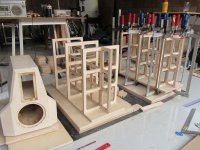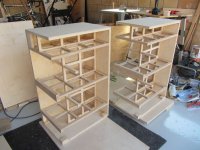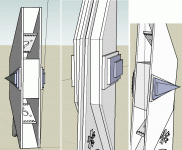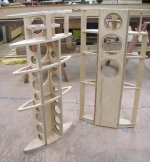Your reasoning is correct but there's no single correct solution to that issue.
If the bass enclosure is mechanically coupled to the mid-range enclosure, vibrations at resonance will interfere with midrange.
Also, raising the resonance frequency instead of attenuating it brings it closer to content (200-300Hz) and may be considered a source of coloration.
I did a test a couple of years ago with a single 200lt bass enclosure. I had very good results by applying three layers of 3mm bitumen sheets (well glued using contact glue) to the inside. It increased the mass and reduced the resonance frequency from 100Hz to 80Hz and also attenuated the output from the enclosure panels by about 20dB at resonance peaks. I like that better but didn't like the significant increase in weight.
If the bass enclosure is mechanically coupled to the mid-range enclosure, vibrations at resonance will interfere with midrange.
Also, raising the resonance frequency instead of attenuating it brings it closer to content (200-300Hz) and may be considered a source of coloration.
I did a test a couple of years ago with a single 200lt bass enclosure. I had very good results by applying three layers of 3mm bitumen sheets (well glued using contact glue) to the inside. It increased the mass and reduced the resonance frequency from 100Hz to 80Hz and also attenuated the output from the enclosure panels by about 20dB at resonance peaks. I like that better but didn't like the significant increase in weight.
Just a related question if I might..............
Apart from aesthetics, is there any reason I can't add stiffening braces to the outside of an enclosure rather than the inside? And in terms of stiffening or adding mass couldn't I simply double the thickness of the enclosure material (ply or mdf, or even a laminate of both materials). although this would double the weight it would avoid having to create complicated shaped accurately joined internally that have to dodge the drivers, etc.
Apart from aesthetics, is there any reason I can't add stiffening braces to the outside of an enclosure rather than the inside? And in terms of stiffening or adding mass couldn't I simply double the thickness of the enclosure material (ply or mdf, or even a laminate of both materials). although this would double the weight it would avoid having to create complicated shaped accurately joined internally that have to dodge the drivers, etc.
Last edited:
Braces on the outside would get involved in diffraction duties and create several parasitic sources of high frequencies.
Regarding using double wall ply or mdf, imho, these are simply transparent to low frequency sound waves and vibration. In my experiment, I used a 20lt sub enclosure with a 12" woofer mounted inside the 200lt enclosure on rubber feet. At a 50W output from the amplifier, I could really listen to a muffled version of the sound, be it music or test tones.
It is much more effective to create two different density layers instead of twice the thickness of the same material. Even better to make three layers with a compliant material sandwiched. That may be so much more effective so as to be able to help keep widths and masses down for an overall lower weight.
Of course this is just one school of thought. There are many considering the enclosure needs to be as stiff as possible and will discount one made of compliant panels.
Regarding using double wall ply or mdf, imho, these are simply transparent to low frequency sound waves and vibration. In my experiment, I used a 20lt sub enclosure with a 12" woofer mounted inside the 200lt enclosure on rubber feet. At a 50W output from the amplifier, I could really listen to a muffled version of the sound, be it music or test tones.
It is much more effective to create two different density layers instead of twice the thickness of the same material. Even better to make three layers with a compliant material sandwiched. That may be so much more effective so as to be able to help keep widths and masses down for an overall lower weight.
Of course this is just one school of thought. There are many considering the enclosure needs to be as stiff as possible and will discount one made of compliant panels.
Sorry to butt into someone else’s thread but I have a similar question in my “brainstorm checking” thread here.
Project Idea - comments please
My proposal combines the same ideas as the OP’s I think -
Thoughts please.
Project Idea - comments please
My proposal combines the same ideas as the OP’s I think -
- Make a floor standing enclosure (bass reflex, TMWW, 40l, twin Es180tia woofers with 30hz port) with a semi elliptical curved enclosure to reduce horizontal standing waves,
- Make the box from the following highly bonded sandwich - 2.5mm aluminium skin (mainly aesthetic), 5mm flexiply, 5mm rubber, 5mm flexiply, 5mm rubber, 5mm flexiply = 26.5mm shell. Baffle will be 28mm butchers block worktop in beech.
- Three window pane braces unequally spaced above, inbetween and below the woofers
- Dampen using the Troels schematic (denim lined plus Behind woofers, top and bottom acoustistuff)
- Mid will be in separate enclosure approx 2.5l made from drainage pipe, moderately stuffed and bitumen lined in and out.
Thoughts please.
Last edited:
Constrained layer damping might be interesting.
YouTube
And this oldie is still a good source:
http://downloads.bbc.co.uk/rd/pubs/reports/1977-03.pdf
YouTube
And this oldie is still a good source:
http://downloads.bbc.co.uk/rd/pubs/reports/1977-03.pdf
Am I even close?
Yes,
also make separate cabinets for bass and mid/high, so vibrations from bass are not transmitted to mid/high.
To decouple use something like the excellent Sylomer SR110.
Make the front panel 2-3x thicker than the other panels.
Attachments
Yes,
also make separate cabinets for bass and mid/high, so vibrations from bass are not transmitted to mid/high.
To decouple use something like the excellent Sylomer SR110.
Make the front panel 2-3x thicker than the other panels.
But here i saw symetrical bracings, which end up with a lot of pieces of panels (same size!) with same tuning frequency
.....hopefully out of woofers frequency range
Last edited:
But here i saw symetrical bracings, which end up with a lot of pieces of panels (same size!) with same tuning frequency
.....hopefully out of woofers frequency range
No, they are not symmetric, the bracing/holes differ some centimeters from each other.
My gut instinct tells me the flexiply is going to resonate like mad between braces. When I have used it in boatbuilding it was like like juggling eels.
My aim would be to use something like roofing adhesive (stays semi flexible and used to bond dissimilar materials) to glu the ally, ply and rubber layers together to make a monolithic composite (sorry I think that is an oxymoron!). I have ideas about building a former to build it in to hep keep the shape and making it over large and then routing to size.
Inspiration was here, but with two of the layers replaced with rubber and an ally skin added to the outside.
Clearwave RBR curved cabinet build
Apart from aesthetics, is there any reason I can't add stiffening braces to the outside of an enclosure rather than the inside?
Not at all. Some of the Fostex facorty horns have some of this to a minimal extent and in this design it was made part of the aesthetics.
dave
Attachments
[*]Three window pane braces unequally spaced above, inbetween and below the woofers
Ideally a brace should be placed such that the subpanels have unequal but higher aspect ratio than the original panel… a horizontal window pane brace in a floorstander as described can actually exacerbate the resonances — at least yours are not equally spaced.
dave
My gut instinct tells me the flexiply is going to resonate like mad between braces.
My gut felling as well, but the one build we did do using this material does not exhibit any issues.
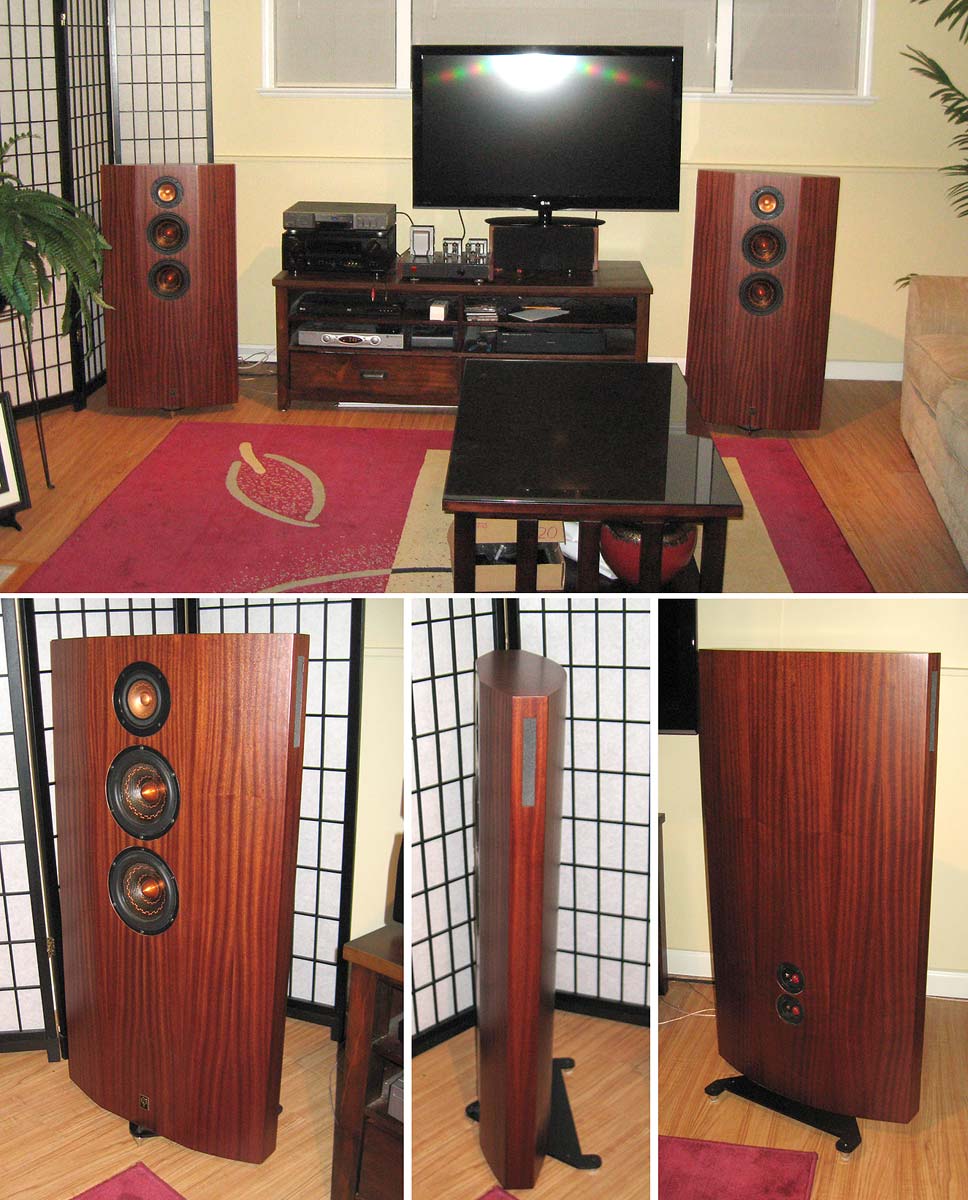
dave
Tim, short answer, yes - specifically yellow cabinet makers glue (Titebond II or Dural equivalent). Standard practice in our particular commercial mill work fabrication of curved reception wall, overhead bulkhead, etc. Three layers of rubber ply, thick coat of yellow glue to each of the 4 internal faces - the very open grain and rough faces of the meranti veneer used in this particular brand is very absorbent- and approx 4 hrs in vacuum bag on a purpose made form not the skeletal frame in the photos. A single layer of the ply is very flexy, but 3 layers ( which closely matches the thickness of nominal 3/4” ply used for the flat front panel on which the drivers were installed) fabricated this way makes for a quite rigid assembly. There are a variety of pre kerfed panel materials that could also be used, but I’d never had luck with them not telegraphing the “seam” of each kerf through the finish layers.
P.S. yes, also a single layer of 1/8” contact cemented on the rubber ply panels for smooth substrate for the final veneer. Embarrassed to say I can’t remember now if that was MDF or BB ply.
Nominal thickness of the rubber ply is 1/4” - just under 6mm.
P.S. yes, also a single layer of 1/8” contact cemented on the rubber ply panels for smooth substrate for the final veneer. Embarrassed to say I can’t remember now if that was MDF or BB ply.
Nominal thickness of the rubber ply is 1/4” - just under 6mm.
Last edited:
- Status
- This old topic is closed. If you want to reopen this topic, contact a moderator using the "Report Post" button.
- Home
- Loudspeakers
- Multi-Way
- Enclosures: mass, bracing, damping etc
